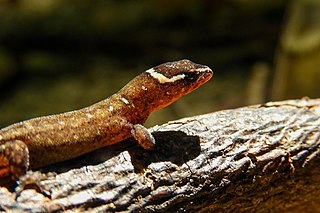
Lepidoblepharis is a genus of Central and South American dwarf geckos in the family Sphaerodactylidae, commonly known as scaly-eyed geckos.

The common woolly monkey, brown woolly monkey, or Humboldt's woolly monkey is a woolly monkey from Colombia, Ecuador, Peru, Bolivia, Brazil, and Venezuela. It lives in groups of two to 70 individuals, usually splitting the group into smaller subgroups when active.

The long-billed hermit is a bird in the family Trochilidae, the hummingbirds. It is found from central Mexico south through Central America, Colombia and Ecuador into Peru.

Transandinomys bolivaris, also known as the long-whiskered rice rat, is a rodent in the family Cricetidae. It is found in humid forest from northeastern Honduras to western Ecuador, up to 1,800 m (5,900 ft) above sea level. Since it was first described in 1901 from Ecuador, six scientific names have been introduced for it, but their common identity was not documented until 1998 and the species has long been known under the name Oryzomys bombycinus, described from Panama in 1912. The name Oryzomys bolivaris was used before it was moved to the new genus Transandinomys with Transandinomys talamancae in 2006.
The Paraguanan ground gecko is a species of lizard in the family Sphaerodactylidae.

Thomasomys ucucha, also known as the ucucha thomasomys, is a rodent in the genus Thomasomys of the family Cricetidae. It is known only from high altitude forest and grassland habitats in the Cordillera Oriental of Ecuador. Seven other species of Thomasomys live in the same areas. First collected in 1903, T. ucucha was formally described as a new species in 2003 and most closely resembles T. hylophilus, which occurs further to the north. The species is listed as "vulnerable" in the IUCN Red List as a result of habitat destruction.
Lepidoblepharis buchwaldii is a species of gecko, a lizard in the family Sphaerodactylidae. The species is endemic to Ecuador.
Lepidoblepharis colombianus is a species of gecko, a lizard in the family Sphaerodactylidae. The species is endemic to Colombia.

Lepidoblepharis duolepis is a species of gecko, a lizard in the family Sphaerodactylidae. The species is endemic to Colombia.
The brown dwarf gecko, also known commonly as the Amazonian scaly-eyed gecko, is a species of lizard in the family Sphaerodactylidae. The species is endemic to north-western South America.
Lepidoblepharis grandis is a species of gecko, a lizard in the family Sphaerodactylidae. The species is endemic to Ecuador.
Lepidoblepharis intermedius is a species of gecko, a lizard in the family Sphaerodactylidae. The species is endemic to northern South America.
Lepidoblepharis microlepis is a species of gecko, a lizard in the family Sphaerodactylidae. The species is endemic to Colombia.

Lepidoblepharis miyatai is a species of gecko, a lizard in the family Sphaerodactylidae. The species is endemic to Colombia.
Lepidoblepharis peraccae is a species of gecko, a lizard in the family Sphaerodactylidae. The species is endemic to western Colombia.
Lepidoblepharis ruthveni is a species of gecko, a lizard in the family Sphaerodactylidae. The species is endemic to northwestern South America.
Lepidoblepharis sanctaemartae is a species of gecko, a lizard in the family Sphaerodactylidae. The species is found in southern Central America and northern South America.
Lepidoblepharis williamsi is a species of gecko, a lizard in the family Sphaerodactylidae. The species is endemic to Colombia.

Lepidoblepharis xanthostigma, also known as the yellow-spotted gecko is a species of gecko, a lizard in the family Sphaerodactylidae. The species is found in Central America and north-western South America.

Sturnira koopmanhilli is a species of leaf-nosed bat found in South America.








